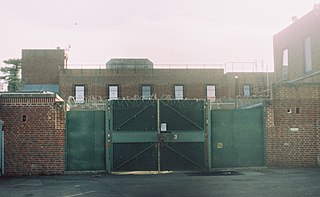
The Territory of Christmas Island is an Australian external territory in the Indian Ocean comprising the island of the same name. It is located approx. 350 kilometres south of Java and Sumatra and about 1,550 km (840 nmi) north-west of the closest point on the Australian mainland. It has an area of 135 square kilometres (52 sq mi).

Serco Group plc is a British multinational defence, health, space, justice, migration, customer services, and transport company. It is headquartered in Hook, Hart, England. The company operates in Continental Europe, the Middle East, the Asia Pacific region, including Australia and Hong Kong, and North America. It is listed on the London Stock Exchange and is a constituent of the FTSE 250 Index.

The Woomera Immigration Reception and Processing Centre (IRPC) was an Australian immigration detention facility near the village of Woomera in South Australia. It was opened in November 1999 in response to an increase in unauthorised arrivals, which had exceeded the capacity of other detention facilities. It was originally intended to hold 400 people, however at its peak in April 2000 it had nearly 1,500 detainees. After ongoing public pressure in response to several well publicised riots from 2000, accusations of human rights abuses, and capacity issues, the centre closed in April 2003.

The Pacific Solution is the name given to the government of Australia's policy of transporting asylum seekers to detention centres on island nations in the Pacific Ocean, rather than allowing them to land on the Australian mainland. Initially implemented from 2001 to 2007, it had bipartisan support from the Coalition and Labor opposition at the time. The Pacific Solution consisted of three central strategies:

Australian immigration detention facilities comprise a number of different facilities throughout Australia, including the Australian territory of Christmas Island. Such facilities also exist in Papua New Guinea and Nauru, namely the Nauru Regional Processing Centre and the Manus Regional Processing Centre.

Villawood Immigration Detention Centre, originally Villawood Migrant Hostel or Villawood Migrant Centre, split into a separate section named Westbridge Migrant Hostel from 1968 to 1984, is an Australian immigration detention facility located in the suburb of Villawood in Sydney, Australia.

The Nauru Regional Processing Centre is an offshore Australian immigration detention facility in use from 2001 to 2008, from 2012 to 2019, and from September 2021. It is located on the South Pacific island nation of Nauru and run by the Government of Nauru. The use of immigration detention facilities is part of a policy of mandatory detention in Australia.
Immigration detention is the policy of holding individuals suspected of visa violations, illegal entry or unauthorized arrival, as well as those subject to deportation and removal until a decision is made by immigration authorities to grant a visa and release them into the community, or to repatriate them to their country of departure. Mandatory detention refers to the practice of compulsorily detaining or imprisoning people seeking political asylum, or who are considered to be illegal immigrants or unauthorized arrivals into a country. Some countries have set a maximum period of detention, while others permit indefinite detention.

Inverbrackie is a place within the locality of Woodside in the Australian state of South Australia located about 3 kilometres (1.9 mi) from the 'town centre' in Woodside.

Yarl's Wood Immigration Removal Centre is a detention centre for foreign nationals prior to their deportation from the United Kingdom, one of 10 such centres currently in the UK. It is located near Milton Ernest in Bedfordshire, England, and is operated by Serco, which describes the place as "a fully contained residential centre housing adult women and adult family groups awaiting immigration clearance." Its population is, and has been, overwhelmingly female.
George Newhouse is an Australian human rights lawyer and a former local councillor. He is the principal solicitor of the National Justice Project, a human rights and social justice legal service, and currently an Adjunct Professor of Law at Macquarie University. and at the University of Technology Sydney.

The Australian government has a policy and practice of detaining in immigration detention facilities non-citizens not holding a valid visa, suspected of visa violations, illegal entry or unauthorised arrival, and those subject to deportation and removal in immigration detention until a decision is made by the immigration authorities to grant a visa and release them into the community, or to repatriate them to their country of origin/passport. Persons in immigration detention may at any time opt to voluntarily leave Australia for their country of origin, or they may be deported or given a bridging or temporary visa. In 1992, Australia adopted a mandatory detention policy obliging the government to detain all persons entering or being in the country without a valid visa, while their claim to remain in Australia is processed and security and health checks undertaken. Also, at the same time, the law was changed to permit indefinite detention, from the previous limit of 273 days. The policy was instituted by the Keating government in 1992, and was varied by the subsequent Howard, Rudd, Gillard, Abbott, Turnbull, Morrison and Albanese Governments. The policy is regarded as controversial and has been criticised by a number of organisations. In 2004, the High Court of Australia confirmed the constitutionality of indefinite mandatory detention of non-citizens. However, this interpretation was overturned in a landmark decision, NZYQ v Minister for Immigration, in 2023, with the High Court concluding the practice was unlawful and unconstitutional.

Campsfield House was an immigration detention centre located in Kidlington near Oxford, England, operated by private prison firm Group 4 under contract with the British government. For 25 years, it was the site of a regular monthly protest from human rights campaigners and saw a number of internal protests, hunger strikes and two suicides. However, it was highly praised by the Chief Inspector of Prisons at the last full inspection in 2014. Campsfield closed in 2018.
Illegal immigration to Australia is defined by the Migration Act 1958, which distinguishes between "lawful non-citizens" and "unlawful non-citizens".
Asylum in Australia has been granted to many refugees since 1945, when half a million Europeans displaced by World War II were given asylum. Since then, there have been periodic waves of asylum seekers from South East Asia and the Middle East, with government policy and public opinion changing over the years.
Reza Barati was a 23-year-old asylum seeker who was killed during rioting at the Manus Island Regional Processing Centre (MIRPC), Papua New Guinea, on 17 February 2014. An Iranian Kurd, he had arrived in Australia on 24 July 2013 – just five days after the PNG solution was announced – and was sent to Manus Island in August.

The Manus Regional Processing Centre, or Manus Island Regional Processing Centre (MIRCP), was one of a number of offshore Australian immigration detention facilities. The centre was located on the PNG Navy Base Lombrum on Los Negros Island in Manus Province, Papua New Guinea.
Immigration detention in the United Kingdom is the practice of detaining foreign nationals for the purpose of immigration control. Unlike some other countries, UK provisions to detain are not outlined in a codified constitution. Instead, immigration enforcement holds individuals under Powers granted in the Immigration Act 1971 and by the Home Office Detention Centre Rules (2001). The expressed purpose of immigration detention is to "effect removal; initially to establish a person's identity or basis of claim; or [implement] where there is reason to believe that the person will fail to comply with any conditions attached to a grant of immigration bail." Detention can only lawfully be exercised under these provisions where there is a "realistic prospect of removal within a reasonable period".
The Murugappan family, also known as the Nadesalingam family, consists of Nadesalingam Murugappan (Nades), his wife Kokilapathmapriya Nadesalingam (Priya) and their two daughters. They are Sri Lankan Tamils seeking asylum in Australia. The couple married in Australia after arriving separately on people smuggler boats; their children were subsequently born in Australia. Until their detention by the Australian Border Force in March 2018, the family, which was resident in the central Queensland town of Biloela, was consequently referred to as the Biloela family by some media. The cause of the couple and their children has been supported by some residents of Biloela as well as asylum-seeker advocates. The Australian federal government of the time assessed them not to be refugees and, consequently, detained and sought to remove them.
Brigid Arthur, csb, also known as Marie Brigid Arthur, and Marie Therese/a Arthur, is an Australian Brigidine sister, educator, refugee advocate and activist on social issues.













